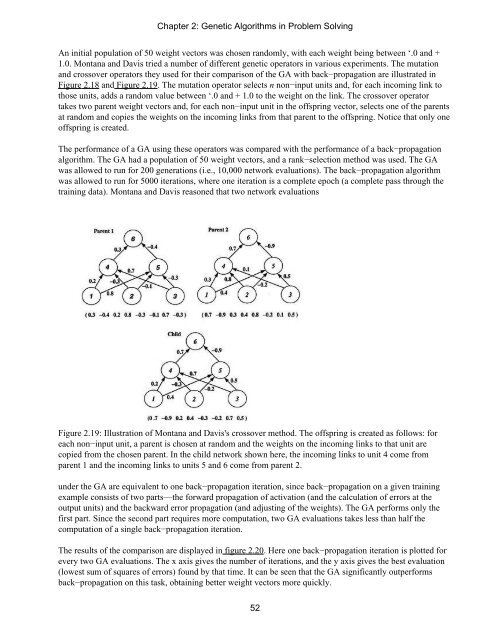An Introduction to Genetic Algorithms - Boente
An Introduction to Genetic Algorithms - Boente
An Introduction to Genetic Algorithms - Boente
You also want an ePaper? Increase the reach of your titles
YUMPU automatically turns print PDFs into web optimized ePapers that Google loves.
Chapter 2: <strong>Genetic</strong> <strong>Algorithms</strong> in Problem Solving<br />
<strong>An</strong> initial population of 50 weight vec<strong>to</strong>rs was chosen randomly, with each weight being between ‘.0 and +<br />
1.0. Montana and Davis tried a number of different genetic opera<strong>to</strong>rs in various experiments. The mutation<br />
and crossover opera<strong>to</strong>rs they used for their comparison of the GA with back−propagation are illustrated in<br />
Figure 2.18 and Figure 2.19. The mutation opera<strong>to</strong>r selects n non−input units and, for each incoming link <strong>to</strong><br />
those units, adds a random value between ‘.0 and + 1.0 <strong>to</strong> the weight on the link. The crossover opera<strong>to</strong>r<br />
takes two parent weight vec<strong>to</strong>rs and, for each non−input unit in the offspring vec<strong>to</strong>r, selects one of the parents<br />
at random and copies the weights on the incoming links from that parent <strong>to</strong> the offspring. Notice that only one<br />
offspring is created.<br />
The performance of a GA using these opera<strong>to</strong>rs was compared with the performance of a back−propagation<br />
algorithm. The GA had a population of 50 weight vec<strong>to</strong>rs, and a rank−selection method was used. The GA<br />
was allowed <strong>to</strong> run for 200 generations (i.e., 10,000 network evaluations). The back−propagation algorithm<br />
was allowed <strong>to</strong> run for 5000 iterations, where one iteration is a complete epoch (a complete pass through the<br />
training data). Montana and Davis reasoned that two network evaluations<br />
Figure 2.19: Illustration of Montana and Davis's crossover method. The offspring is created as follows: for<br />
each non−input unit, a parent is chosen at random and the weights on the incoming links <strong>to</strong> that unit are<br />
copied from the chosen parent. In the child network shown here, the incoming links <strong>to</strong> unit 4 come from<br />
parent 1 and the incoming links <strong>to</strong> units 5 and 6 come from parent 2.<br />
under the GA are equivalent <strong>to</strong> one back−propagation iteration, since back−propagation on a given training<br />
example consists of two parts—the forward propagation of activation (and the calculation of errors at the<br />
output units) and the backward error propagation (and adjusting of the weights). The GA performs only the<br />
first part. Since the second part requires more computation, two GA evaluations takes less than half the<br />
computation of a single back−propagation iteration.<br />
The results of the comparison are displayed in figure 2.20. Here one back−propagation iteration is plotted for<br />
every two GA evaluations. The x axis gives the number of iterations, and the y axis gives the best evaluation<br />
(lowest sum of squares of errors) found by that time. It can be seen that the GA significantly outperforms<br />
back−propagation on this task, obtaining better weight vec<strong>to</strong>rs more quickly.<br />
52






